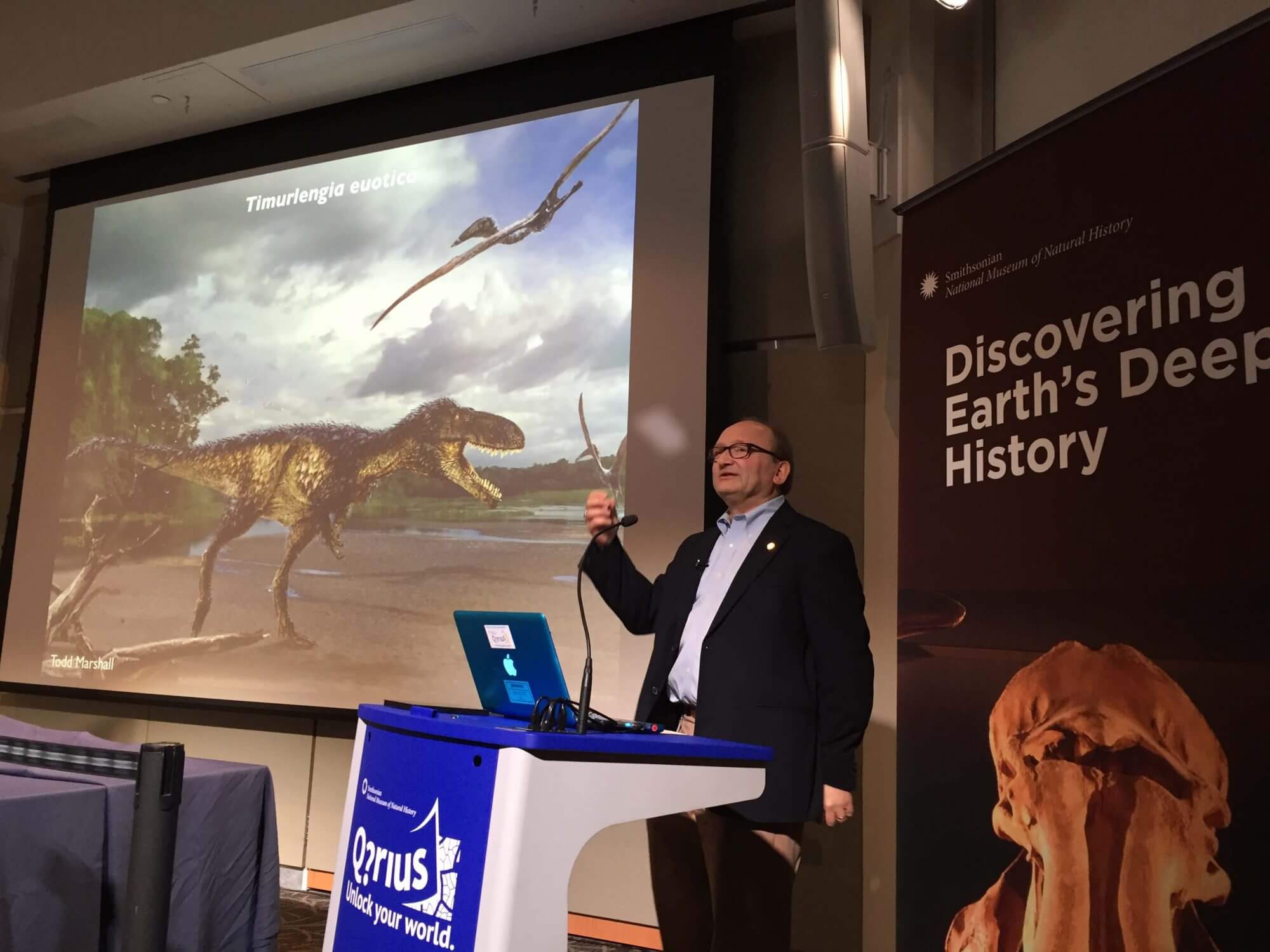
An artist’s depiction of Timurlengia euotica, a newly discovered ancestor of the Tyrannosaurus Rex, which lived 90 million years ago. (Todd Marshall/Smithsonian)
WASHINGTON — A newly discovered species, an ancestor of the Tyrannosaurus rex, sheds light on how tyrannosaurs evolved from small man-sized predators into the iconic dinosaur we know from Jurassic Park, scientists announced Monday.
Smithsonian paleobiologist Hans Sues – Dr. Sues, to the journalists who gathered in the Museum of Natural History to pepper him with questions about his team’s discovery – held aloft a single tooth, about the size of one of his fingers, with a serrated edge he warned could still draw blood from a careless scientist.
The tooth, he said, along with a braincase, a jaw fragment and several vertebrae, belong to a close ancestor of the T. rex, dubbed Timurlengia euotica, which was about the size of a horse and lived around 90 million years ago.
This new addition to the tyrannosaur family reveals that this breed of dinosaur got very big, very fast, just before it was wiped out by an asteroid strike that took 75 percent of life on Earth out with it. But it also shows that the ancestors to the giant, intelligent T. rex developed their smarts before they got their size.
Two things struck scientists about the find, which Seus made in an Uzbek desert along with Russian scientist Alexander Averianov during a dig that lasted from 1997 to 2006.

Fossil remains of Timurlengia, mapped onto what scientists think its skeleton would have looked on. (Courtesy of the National Academy of Sciences)
The first was that Timurlengia, which lived not long before the T. rex, was surprisingly small. The first tyrannosaurs – those that came before the new discovery — lived about 170 million years ago and were only slightly larger than a human. But 100 million years later, the tyrannosaur familiy had given rise to the T. rex, massive animals that could weigh up to seven tons. The fact that Timurlengia lived just 20 million years before T. rex and weighed a paltry 600 pounds, Seus said, shows that most of tyrannosaurs’ evolutionary growth came right at the end of their existence.
The second was the size of Timurlengia’s braincase, which Seus called the “Rosetta Stone” of the project. Using CT scans of the fossil, paleontologists working under Steve Brusatte of the University of Edinburgh reconstructed what Timurlengia’s brain must have looked like. Their analysis revealed that although this species’ skull was much smaller than T. rex, it had the same highly developed senses and cognitive abilities of its more famous descendant.
“Now we know that those sensory features actually evolved earlier in smaller, more primitive tyrannosaurus,” Brusatte said, “and they’re the kind of things that may have been part of that package of ‘superpowers’ that allowed tyrannosaurs to rise to the top of the food chain when evolution presented an opportunity.”

Sues holds a 3-D printed cast of a Timurlengia brain cavity made from Brusatte’s CT scan during his presentation Monday morning. (Nicolas Rivero/MEDILL)
That’s exactly what T. rex did when other groups of large, meat-eating dinosaurs became extinct about 80 or 90 million years ago. Sues and Brusatte said that tyrannosaurs’ intelligence made them perfect candidates to be superpredators, and that they exploded in size as soon as their larger competitors died out.
“What this is is an evolutionary story. How did the king get its crown?” Brusatte said, telling his audience that they probably wouldn’t have been very impressed with the oldest, smallest tyrannosaurs. “But given enough time and the right opportunities, they were able to beat the odds and become the most iconic dinosaurs to ever live.”
“And then right when T. rex was in its prime,” Brusatte added, “rampaging across all of western North America, literally as dominant as any animal could be…that asteroid fell out of the sky, the world changed in an instant, and then our ancestors came into the picture.”

Hans Sues excavating a fossil in the Kyzylkum Desert of Uzbekistan in September, 2006 (Hans Suess/Smithsonian)
Sues, who has now discovered nine species of dinosaur, said the next step would be to find tyrannosaur remains from 80 to 90 million years ago. These would show just how quickly the family evolved in size before giving rise to T. rex. With visible delight, Sues said he is looking into a site in Kazakhstan that has rocks that are about the right age.
“Children fall into two groups, generally,” the German scientist explained during the question and answer session following his announcement. “There are the T. rex fans and the triceratops fans. I’ve always been a T. rex person, but that’s because I’m a carnivore myself, growing up in the land of sausages and beer. If I had grown up in a vegetarian or vegan household I might have favored triceratops.”



